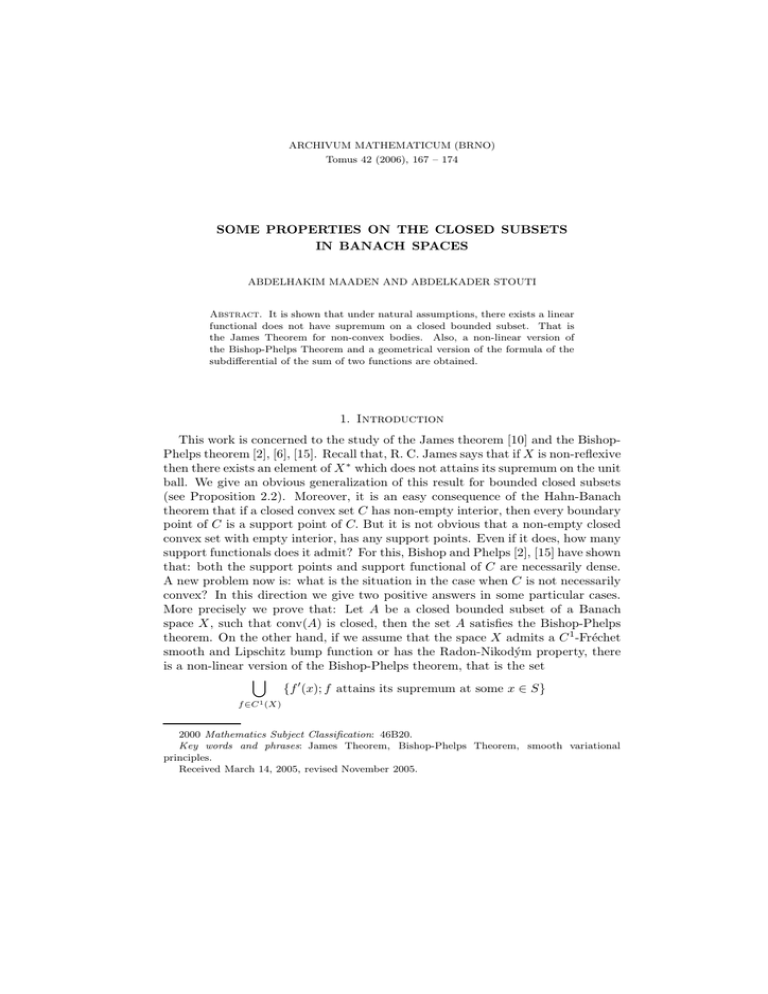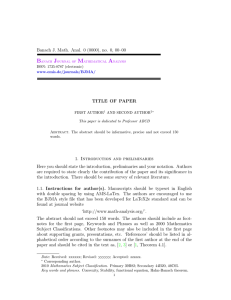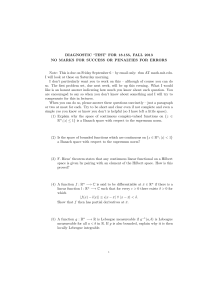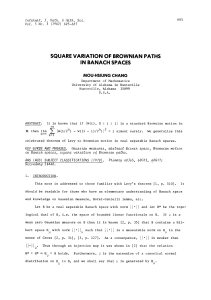SOME PROPERTIES ON THE CLOSED SUBSETS IN BANACH SPACES
advertisement

ARCHIVUM MATHEMATICUM (BRNO)
Tomus 42 (2006), 167 – 174
SOME PROPERTIES ON THE CLOSED SUBSETS
IN BANACH SPACES
ABDELHAKIM MAADEN AND ABDELKADER STOUTI
Abstract. It is shown that under natural assumptions, there exists a linear
functional does not have supremum on a closed bounded subset. That is
the James Theorem for non-convex bodies. Also, a non-linear version of
the Bishop-Phelps Theorem and a geometrical version of the formula of the
subdifferential of the sum of two functions are obtained.
1. Introduction
This work is concerned to the study of the James theorem [10] and the BishopPhelps theorem [2], [6], [15]. Recall that, R. C. James says that if X is non-reflexive
then there exists an element of X ∗ which does not attains its supremum on the unit
ball. We give an obvious generalization of this result for bounded closed subsets
(see Proposition 2.2). Moreover, it is an easy consequence of the Hahn-Banach
theorem that if a closed convex set C has non-empty interior, then every boundary
point of C is a support point of C. But it is not obvious that a non-empty closed
convex set with empty interior, has any support points. Even if it does, how many
support functionals does it admit? For this, Bishop and Phelps [2], [15] have shown
that: both the support points and support functional of C are necessarily dense.
A new problem now is: what is the situation in the case when C is not necessarily
convex? In this direction we give two positive answers in some particular cases.
More precisely we prove that: Let A be a closed bounded subset of a Banach
space X, such that conv(A) is closed, then the set A satisfies the Bishop-Phelps
theorem. On the other hand, if we assume that the space X admits a C 1 -Fréchet
smooth and Lipschitz bump function or has the Radon-Nikodým property, there
is a non-linear version of the Bishop-Phelps theorem, that is the set
[
{f ′ (x); f attains its supremum at some x ∈ S}
f ∈C 1 (X)
2000 Mathematics Subject Classification: 46B20.
Key words and phrases: James Theorem, Bishop-Phelps Theorem, smooth variational
principles.
Received March 14, 2005, revised November 2005.
168
A. MAADEN AND A. STOUTI
∗
is
S is a closed and bounded
subset of X and C 1 (X) :=
norm dense in X where
1
f : X −→ R; f is a C -Fréchet smooth function . This is a consequence of the
smooth variational principles [4], [5]. As we shall study an application of the
smooth variational principle of Deville [4], we give a geometrical version of the
formula of the sum of the subdifferential of two functions (see Theorem 2.7).
2. Main results
Recall that James theorem [10] states that for every convex body B in a nonreflexive Banach space X there exists a continuous linear functional f ∈ X ∗ such
that f does not attains its supremum on B. We give the same result in the case
when B is just a closed bounded subset.
For this, we us the same techniques as in [1] and we give the following lemma
which is the key of the proof of our results:
Lemma 2.1. Let (X, k·k) be a Banach space. Let A be a closed subset of X. Let
f : X → R be a convex and lower semi-continuous function. Let C = conv (A).
Then sup {f (x) ; x ∈ C} = sup {f (x) ; x ∈ A}.
Proof. We have A ⊂ C, then supA f ≤ supC f =: α.
Let ε > 0 so, α > α − (ε/2). Then there exists c ∈ C such that
f (c) ≥ α − (ε/2)
(1)
We have c ∈ conv (A) and f is lower semi-continuous. Then there exists a
neighborhood U of c and x ∈ U ∩ conv (A) such that
f (c) ≤ f (x) + (ε/2) .
(2)
Combining (1) and (2) we obtain that:
α − ε ≤ f (x)
(3)
In other hand, x ∈ conv (A), there exists (ai )i≤n in A and (ti )i≤n in [0, 1] such
n
n
n=1
P
P
P
ti f (ai ).
ti ai . Since f is convex, f (x) ≤
ti = 1 and x =
that
i=1
i=1
i=1
We confirm that there is ai ∈ A such that f (ai ) ≥ α − ε. Assume the contrary,
n
n
P
P
ti (α − ε) = (α − ε).
ti f (ai ) <
then f (ai ) < α − ε for all i. Thus f (x) ≤
i=1
i=1
Therefore, f (x) < α − ε, a contradiction with (3) . Then for all ε > 0 there exists
a ∈ A such that f (a) ≥ α − ε, which means that supA f ≥ α and the proof of our
lemma is complete.
Now, we are ready to prove a James like theorem for non-convex bodies:
Proposition 2.2. Let (X, k·k) be a non-reflexive Banach space. Let A be a closed
and bounded subset of X. Then, there exists a linear functional x∗ in X ∗ such
that x∗ has no supremum on A.
Proof. Let C = conv (A). By hypothesis X is non-reflexive then, by James
theorem there exists a linear functional x∗ in X ∗ such that x∗ has no supremum
SOME PROPERTIES ON THE CLOSED SUBSETS IN BANACH SPACES
169
on C. By Lemma 2.1, we have supA x∗ = supC x∗ . So that, x∗ has no supremum
on A and the proof is complete.
Let A be a subset of a Banach space X. Put:
MA = x∗ ∈ X ∗ ; sup x∗ = hx∗ , x0 i for some x0 ∈ A .
A
Recall that the Bishop-Phelps theorem [2], [6], [15] says that the set MA is norm
dense in X ∗ whenever A is a closed, bounded and convex subset of X.
In the case when A is not a convex subset we give the following generalization
of the Bishop-Phelps theorem:
Proposition 2.3. Let (X, k·k) be a Banach space. Let A be a closed bounded
subset of X such that conv (A) is closed. Then, the set MA is norm dense in X ∗ .
Proof. Let C = conv (A). By the Bishop-Phelps theorem the set MC is norm
dense in X ∗ . Let ε > 0 and y ∗ ∈ X ∗ , then there exist x0 ∈ C and x∗ ∈ MC such
that hx∗ , x0 i = supC x∗ and kx∗ − y ∗ k < ε. By Lemma 2.1, we have supC x∗ =
supA x∗ .
n
P
ti = 1 and let (ai )1≤i≤n in A be such
Let (ti )1≤i≤n in [0, 1] be such that
that x0 =
n
P
i=1
ti ai . Then,
i=1
(4)
hx∗ , x0 i =
n
X
ti hx∗ , ai i
i=1
Assume that for all 1 ≤ i ≤ n, hx∗ , ai i < hx∗ , x0 i. Then,
n
P
n
P
ti hx∗ , ai i <
i=1
ti hx∗ , x0 i = hx∗ , x0 i, a contradiction with (4). Hence, there exists i ∈ {1, . . . , n}
i=1
such that hx∗ , xi i = hx∗ , x0 i and xi is in A. Therefore x∗ is in MA and the proof
is complete.
Now from Proposition 2.3, one can ask that, what happens if conv(A) is not
closed. In this direction, we give an other type of the Bishop-Phelps theorem in
Banach spaces satisfying some properties. The first result, is in Banach spaces
which admit a Fréchet smooth Lipschitzian bump function. This is a consequence
of the smooth variational principle of Deville-Godefroy-Zizler [4]. The second
result, is in Banach spaces with the Radon-Nikodým property, in this case we us
the smooth variational principle of Deville-Maaden [5].
Recall that, a function which is not identically equal to zero and with bounded
support is called a bump function.
The smooth variational principle of Deville-Godefroy-Zizler says:
Theorem 2.4. Let X be a Banach space which admits a C 1 -Fréchet smooth,
Lipschitz bump function. Then for each ε > 0 and for each lower semi-continuous
and bounded below function f : X −→ R ∪ {+∞} such that f is not identically
170
A. MAADEN AND A. STOUTI
equal to +∞ and for each x1 ∈ X such that f (x1 ) < inf X f + ε, there exists a
C 1 -Fréchet smooth, Lipschitz function g such that
1) kgk∞ = sup{|g(x)|; x ∈ X} < ε,
2) kg ′ k∞ = sup{kg ′ (x)kX ∗ ; x ∈ X} < ε,
3) f + g has its minimum at some point x0 ∈ X,
4) kx1 − x0 k < ε.
A few years ago, it was given in [5] the following smooth variational principle
in Radon-Nikodým spaces.
Theorem 2.5. Let X be a Banach space with the Radon-Nikodým property. Then
for each ε > 0 and for each lower semi-continuous and bounded below function
f : X −→ R ∪ {+∞} not identically equal to +∞, for which there exist a > 0 and
b ∈ R such that f (x) ≥ 2akxk + b for all x ∈ X, there exists a C 1 -Fréchet smooth
function g such that
1) kgk∞ = sup{|g(x)|; x ∈ X} < ε,
2) kg ′ k∞ = sup{kg ′ (x)kX ∗ ; x ∈ X} < ε,
3) g ′ is weakly continuous,
4) f + g has its minimum at some point x0 ∈ X.
These theorems have many consequences in diverse areas of optimization and
non-linear analysis. As an example, we prove the existence of many non-trivial
normal vectors at many points on the boundary of a closed subset of a Banach
space. This is a non-linear version of the Bishop-Phelps theorem:
Theorem 2.6. Let X be a Banach space admitting either C 1 -Fréchet smooth
Lipschitzian bump function or having the Radon-Nikodým property. Let S be a
closed non-void bounded subset of X. Then the set
[
{f ′ (x); f attains its supremum at some x ∈ S}
f ∈C 1 (X)
is norm dense in X ∗ .
Proof. Let x∗ ∈ X ∗ and let ε > 0. Let
g : X −→ R ∪ {+∞}
(
< −x∗ , x >
x 7−→
+∞
if x ∈ S
otherwise
It is clear that g is lower semi-continuous, and since S is bounded, then g is
bounded below.
Case 1. Suppose that the space X admits a C 1 -Fréchet smooth Lipschitzian bump
function.
Therefore, by Theorem 2.4, there exists a C 1 -Fréchet smooth Lipschitz function
ϕ : X −→ R such that kϕk := kϕk∞ + kϕ′ k∞ < ε and g + ϕ has its minimum at
some x0 in S.
SOME PROPERTIES ON THE CLOSED SUBSETS IN BANACH SPACES
171
Let h := x∗ − ϕ. Then h attains its supremum at x0 on S, and we have:
kh′ (x) − x∗ kX ∗ = k − ϕ′ (x)kX ∗ < ε
and the proof is complete in this case.
Case 2. Suppose that the space X satisfies the Radon-Nikodým property.
Since S is bounded, there exists α > 0 such that kxk ≤ α for all x ∈ S. Let
β = inf {< −x∗ , x >; x ∈ S}. Therefore, for all x ∈ S, we have
kxk − α + β ≤ β ≤ h−x∗ , xi
which means that
kxk − α + β ≤ g(x)
for all x ∈ X .
1
Applying now Theorem 2.5, there exists a C -Fréchet smooth function ϕ : X −→ R
such that kϕk := kϕk∞ + kϕ′ k∞ < ε and g + ϕ attains its minimum at some x0
in S.
Let h := x∗ − ϕ. Then h attains its supremum at x0 on S, and we have:
kh′ (x) − x∗ kX ∗ = k − ϕ′ (x)kX ∗ < ε .
Then the proof is complete in this case.
Another consequence of the smooth variational principle of Deville-GodefroyZizler [4] is the following theorem, which can be seen as a geometrical version of
the formula of the subdifferential of the sum of two functions [3], [9].
In all the sequel we denote by N (S, x) the set:
n
o
hx∗ , u − xi
N (S, x) = x∗ ∈ X ∗ ; lim sup
≤0
ku − xk
u→S x
the symbol u →S x means that u → x and u ∈ S.
Theorem 2.7. Let X be a Banach space which admits a C 1 -Fréchet smooth,
Lipschitz bump function b. Let S1 and S2 be two closed subsets of X such that
S1 ∩S2 = ∅. Let ε > 0 and (x1 , x2 ) ∈ S1 ×S2 be such that kx1 −x2 k < d (S1 , S2 )+ε.
Then there are x∗i , xi , i = 1, 2, such that:
1)
2)
3)
4)
5)
xi ∈ Si , i = 1, 2,
kx1 − x2 k < ε + d (S1 , S2 ),
x∗i ∈ N (Si , xi ), i = 1, 2,
kx∗1 + x∗2 k < ε,
1 − (ε/2) < kx∗i k < 1 + (ε/2), i = 1, 2.
Proof. We know that the space X admits a C 1 -Fréchet differentiable, Lipschitz
bump function. According to a construction of Leduc [11], there exists a Lipschitz
function d : X −→ R which is C 1 -Fréchet smooth on X \ {0} and satisfies:
i) d(λx) = λd(x) for all λ > 0 and for all x ∈ X,
ii) there exist α > 0 and β > 0 such that αkxk ≤ d(x) ≤ βkxk for all x ∈ X.
Without loss of generality, we can assume that β = 1.
172
A. MAADEN AND A. STOUTI
Consider the following function:
f : X × X −→ R ∪ {+∞}
(
d(x − y)
(x, y) 7−→
0
if (x, y) ∈ S1 × S2
otherwise
where d is the Leduc function such that d(x) ≤ kxk for all x ∈ X. We assume that
the norm k·k in X ×X satisfies that k(x1 , x2 )−(y1 , y2 )k = kx1 −y1 kX +kx2 −y2 kX .
Let (y1 , y2 ) ∈ S1 × S2 be such that ky1 − y2 k ≤ d(S1 , S2 ) + ε′ where ε′ is such that
0 < 2ε′ < ε. The function f is lower semi-continuous and positive. Thanks to
the smooth variational principle of Deville-Godefroy-Zizler (Theorem 2.4), we find
(x1 , x2 ) ∈ S1 × S2 such that k(x1 , x2 ) − (y1 , y2 )k < ε′ and ϕ ∈ C 1 (X × X) with
kϕk := kϕk∞ + kϕ′ k∞ < ε′ , such that the function f + ϕ attains its minimum at
(x1 , x2 ), and we have
kx1 − x2 k ≤ kx1 − y1 k + ky1 − y2 k + ky2 − x2 k
= k(x1 , x2 ) − (y1 , y2 )kX×X + ky1 − y2 k
≤ ε′ + d(S1 , S2 ) + ε′
< d(S1 , S2 ) + ε .
Let ψ2 (x) = d(x1 − x) + ϕ(x1 , x). We know that for all (x, y) ∈ S1 × S2 :
f (x, y) + ϕ(x, y) ≥ f (x1 , x2 ) + ϕ(x1 , x2 )
in particular for x = x1 ∈ S1 , we obtain that, for all y ∈ S2
f (x1 , y) + ϕ(x1 , y) = d(x1 − y) + ϕ(x1 , y)
≥ d(x1 − x2 ) + ϕ(x1 , x2 ) ,
which means that:
ψ2 (y) ≥ ψ2 (x2 ) , ∀y ∈ S2 .
Since x2 ∈ S2 , x1 ∈ S1 and S1 ∩ S2 = ∅, ψ2 is Fréchet differentiable at x2 .
Consider now the function ψ1 (x) = d(x − x2 ) + ϕ(x, x2 ). The same techniques
show that ψ1 is Fréchet differentiable at x1 and ψ1 (x) ≥ ψ1 (x1 ) for all x ∈ S1 .
According to one proposition of Ioffe [9]: Suppose that f is Fréchet differentiable
at x ∈ S and attains a local minimum on S at this point. Then −f ′ (x) ∈ N (S, x).
We deduce that:
(−ψ1′ (x1 ) , −ψ2′ (x2 )) ∈ N (S1 , x1 ) × N (S2 , x2 ) .
On the other hand, we have:
ψ1′ (x1 ) = d′ (x1 − x2 ) + ϕ′x (x1 , x2 )
and
ψ2′ (x2 ) = −d′ (x1 − x2 ) + ϕ′y (x1 , x2 ) .
Therefore k − ψ1′ (x1 ) − ψ2′ (x2 )k = k − ϕ′x (x1 , x2 ) − ϕ′y (x1 , x2 )k < 2ε′ < ε.
Since kϕ′ k∞ < ε′ and 2ε′ < ε, then 1 − (ε/2) < kψi′ k∞ < 1 + (ε/2), i = 1, 2 and
the proof is complete.
SOME PROPERTIES ON THE CLOSED SUBSETS IN BANACH SPACES
173
Remark. Following [13], we say that two closed subsets S1 and S2 of a Banach
space X generate a extremal system {S1 , S2 } if for some x ∈ S1 ∩ S2 and for any
δ > 0 there is u ∈ X such that kuk < δ and (S1 + u) ∩ S2 = ∅, (for more about
this property and its characterizations see [7], [14]).
1) One can prove Theorem 2.7 replacing the hypothesis S1 ∩ S2 = ∅ by the fact
that S1 and S2 generate a extremal system {S1 , S2 }.
2) It is trivial that the space X = Rn admits a C 1 -Fréchet smooth norm. Then
X admits a C 1 -Fréchet smooth Lipschitz function. So that, Theorem 2.7 holds
true if X = Rn . This particular case was proved by Mordukhovich [12] for two
closed subsets S1 and S2 generate an extremal system {S1 , S2 }.
3) The existence of smooth norm implies the presence of smooth Lipschitz bump
function, but the converse is not true in general. Haydon [8] gives an example of
Banach space with smooth Lipschitz bump function but not have an equivalent
smooth norm.
We deduce that our theorem holds true if the space X have an equivalent Fréchet
smooth norm. This particular case was proved by Ioffe [9] for two closed subsets
S1 and S2 generate an extremal system {S1 , S2 }.
Acknowledgements. The authors will thank the referee for his / her valuable
suggestions and for submitting them the references [7], [13] and [14].
References
[1] Azagra, D., Deville, R., James’ theorem fails for starlike bodies, J. Funct. Anal. 180 (2)
(2001), 328–346.
[2] Bishop, E., Phelps, R. R., The support cones in Banach spaces and their applications, Adv.
Math. 13 (1974), 1–19.
[3] Deville, R., El Haddad, E., The subdifferential of the sum of two functions in Banach spaces,
I. First order case, J. Convex Anal. 3 (2) (1996), 295–308.
[4] Deville, R., Godefroy, G., Zizler, V., A smooth variational principle with applications to
Hamilton-Jacobi equations in infinite dimensions, J. Funct. Anal. 111 (1993), 197–212.
[5] Deville, R., Maaden, A., Smooth variational principles in Radon-Nikodým spaces, Bull.
Austral. Math. Soc. 60 (1999), 109–118.
[6] Diestel, J., Geometry of Banach spaces - Selected topics, Lecture Notes in Math., Berlin –
Heidelberg – New York 485 (1975).
[7] Fabian, M., Mordukhovich, B. S., Separable reduction and extremal principles in variational
analysis, Nonlinear Anal. 49 (2) (2002), 265–292.
[8] Haydon, R., A counterexample in several question about scattered compact spaces, Bull.
London Math. Soc. 22 (1990), 261–268.
[9] Ioffe, A. D., Proximal analysis and approximate subdifferentials, J. London Math. Soc. (2)
41 (1990), 175–192.
[10] James, R. C., Weakly compact sets, Trans. Amer. Math. Soc. 113 (1964), 129–140.
[11] Leduc, M., Densité de certaines familles d’hyperplans tangents, C. R. Acad. Sci. Paris, Sér.
A 270 (1970), 326–328.
[12] Mordukhovich, B. S., Metric approximations and necessary optimality conditions for general
classes of nonsmooth extremal problems, Sov. Math. Dokl. 22 (1980), 526–530.
174
A. MAADEN AND A. STOUTI
[13] Mordukhovich, B. S., Shao, Y. H., Extremal characterizations of Asplund spaces, Proc.
Amer. Math. Soc. 124 (1) (1996), 197–205.
[14] Mordukhovich, B. S., Shao, Y. H., Nonsmooth sequential analysis in Asplund spaces, Trans.
Amer. Math. Soc. 348 (4) (1996), 1235–1280.
[15] Phelps, R. R., Convex functions, Monotone Operators and Differentiability, Lecture Notes
in Math., Berlin – Heidelberg – New York – London – Paris – Tokyo 1364 (1991).
Unité de Recherche Mathématiques et Applications
Faculté des Sciences et Techniques
B.P. 523, Beni - Mellal, Maroc
E-mail: hmaaden2002@yahoo.fr



